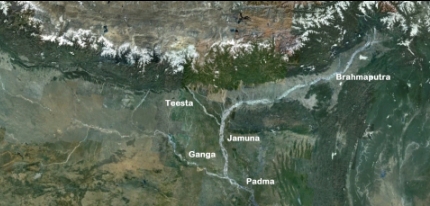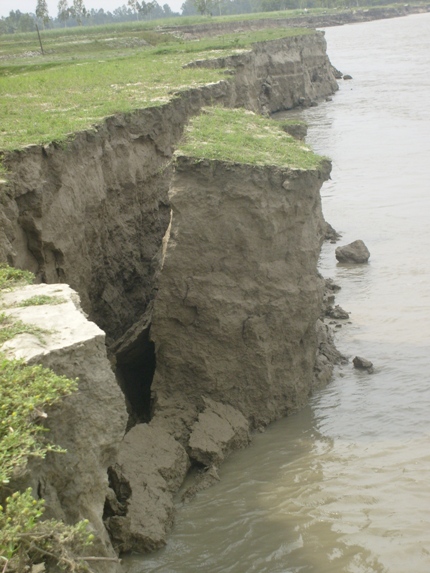“We had two hours in which to remove everything from the school – benches, blackboards, books, everything,” says Mohammad Abdus Salam. “The river broke the bank and the village is no more. Do you see that fishing boat in the distance? That’s where our village was.”
Two years after that catastrophe, the headmaster of Bahuka’s primary school remains a worried man. “Now we are here under a tin shed. The children are scattered, some families have gone elsewhere. We are a kilometre from the riverbank. But we don’t know how long we can run the school here. All we know is that the river will definitely break the bank here as well.”
The river is the Jamuna, formed by the confluence of the Teesta and the mighty Brahmaputra in northern Bangladesh. By the time it reaches Bahuka in Sirajganj district – about 150 kilometres north-west of the capital Dhaka – the many-braided river is already over seven kilometres wide. And it keeps cutting into the banks all the time.
Since 1968, the residents of Bahuka village have seen 10 embankments washed away. Now the eleventh is being built, and they are sure it will be washed away too. The Bangladesh government sanctioned a scheme worth 276 crore Taka (US$35.5 million) a year ago to build a cement embankment, says local council member Jael Hossein, but the work has not been started yet.
Half a kilometre downstream on the same right bank, South Korean experts are trying out a new form of embankment using synthetic materials, and it seems to be holding. But the pilot project does not extend up to Bahuka. The villagers look on enviously.
Mashfiqus Salehin, professor at the Institute of Water and Flood Management in the Bangladesh University of Engineering and Technology, says that it is in the nature of such large braided rivers as the Brahmaputra and the Jamuna to erode banks and at the same time to deposit silt on the riverbed, so that new riverine islands are formed. Since pre-history, that has been a characteristic of the Ganga-Brahmaputra-Meghna delta that encompasses India and Bangladesh. The rich silt carried down from the Himalayas has created and recreated one of the most fertile deltas in the world.
But these transboundary rivers are changing. There is more erosion and less island-building in recent years, and this trend is accelerating.
Scientists advance two hypotheses to explain this.
One, water flows in these rivers that come down from the Himalayas have been increasing due to higher rate of glacier melt in the mountain range and the Tibetan Plateau, due to global warming.
Two, there are hydropower projects under construction in both Brahmaputra and Teesta river basins. During construction, the water is channelled through another part of the river, but a lot of the silt gets held back because it cannot use a channel that is narrower than usual. As a result of the decreased silt flow, island building downstream is reducing, while the erosion continues at the same or even a slightly accelerated rate.
The first hypothesis is largely accepted by hydrologists in India and Bangladesh, who say that over the last two decades, they have been measuring higher water flows between March and May. Scientists at the Institute of Tibetan Plateau Research – a Chinese government organisation – have said that the plateau has been warming at a rate three times higher than the global average. The result is a faster melt rate of glaciers, and consequently more water in the river, so there is more erosion downstream.
Asked about the second hypothesis of silt flow being reduced due to hydropower projects upstream, scientists say they do not have enough data to prove or disprove it. Residents of Bahuka are however convinced that riverine islands (known locally as char) are not being built as often as before.
Atiq Rahman, executive director of the Bangladesh Centre for Advanced Studies (BCAS), says that as more and more people are displaced by erosion and other effects of climate change, the only solution is to teach people how to live with floods and similar calamities.

At a media workshop and field trip organised this month by the third pole and BCAS, Rahman said, “Climate change will hit the poor earliest and hardest, because they have the least capacity to withstand shocks.” He described the various ways in which BCAS was helping people adapt to climate change – building various structures including a homestead garden on a raised plinth, rain water harvesting, building floating gardens on a water hyacinth base, even building floating houses using bamboo and tin fences to protect from erosion and so on.
Ayesha is a 15-year-old resident of Bahuka who has no option but to adapt – she has already been displaced three times as the Jamuna undermined her family home. Every time, she has missed months of schooling. As she prepares for her board examinations next March, she is hoping her school will still be in the same place till then.
Photos by Joydeep Gupta.


